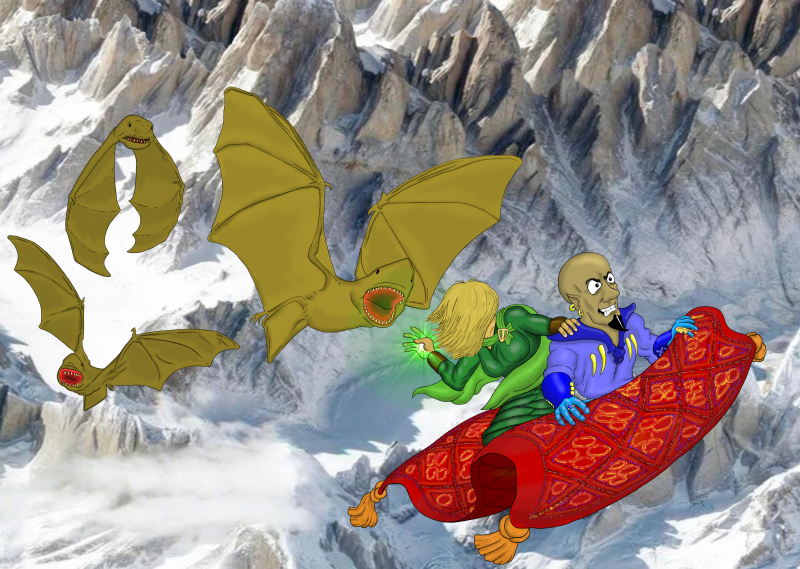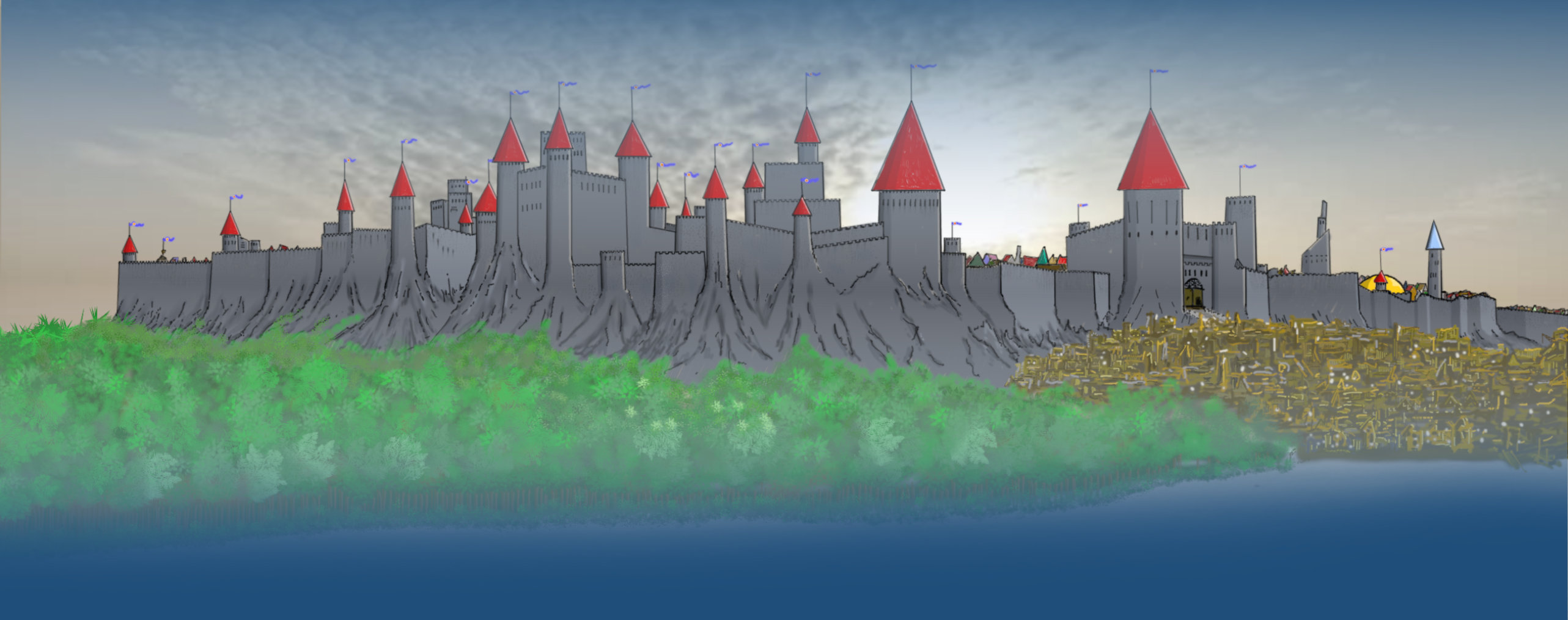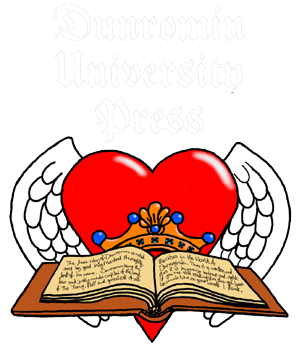Barnaynian Nomenclature
Dated: 19 Jan, 2025

I have been wondering this morning about how we come up with the names of things. A few people have chatted about this on the Facebook pages I am a member of so I thought I would put my ideas and methods down here – as food for thought…
I used to get any old name I liked from any source. They were only meant for the groups I was playing with so it didn’t really matter if they were known to the wider public – copyright wasn’t an issue. In one of the early drafts of Dunromin there was a powerful Baron called Eddard Stark; named from a book series I had read that I really liked. But then A Song of Ice and Fire became the Game Of Thrones franchise and I had to rename my interesting little noble.
Naming ideas often come from accidents and improvisation at the spur of the moment.
I remember once when we were playing back in the noughties and the party were travelling through the Blue Mountains, home of the Hill Dwarf city states. They were peaceful lands but there were important NPCs to meet so we role-played the journey. I had to make up names for the Dwarf Cities as they went and had a brain-lock. I couldn’t think of any names and decided to recycle the names of real places, places I had recently visited as part of my day job. My creative juices were very dry that night.
As they approached yet another Dwarven Fortress town I recall saying “Erm, it’s, oh, I don’t know, ‘Luton’ will do.” Shortly thereafter I needed another name. The brain-lock hadn’t moved so I just said “It’s called, erm, 'London'! Fuck it.” The party chronicler/mapper at that time was Rob Hooley, one of the original Dunromin crew from 1986, and he laughed and dutifully wrote the names down. If you look into the names of the Dwarven cities in SM04 the Gazetteer of the Land of the Young you may notice two Dwarven cities called Lootunulldo and Lundunfukkit, along with others in a similar vein…
Another one of the original crew, Adrian Bell, who is 50% responsible for the then un-named world we were adventuring on becoming banana-shaped, made an observation about how he often disliked the names given in the published sources for the game. He struggles to remember abstract names, like Pech or Duergar, and much prefers names that describe the monster, like Fire Newts or Mind Flayers. At the same time, it had occurred to me that different cultures would have different names for things, sometimes more than one name. For instance, in English we have the name Butterfly for a group (genus?) of insects; the French call them Papillon, the Germans call them Schmetterling. Both wonderful words in themselves, I think.
As a result of this, we have started giving the monsters we create multiple names, reflecting the cultures the players might be from or have to interact with. The first example of this was the Deep Race, from SM02 The Games Master's Guide to Dunromin. This was a replacement for Mind Flayers, which I couldn’t use for copyright reasons, but quickly morphed into Alien-Xenomorph-like creatures with psychic powers and low intelligence. They were created by the mysterious “Old Ones” (thank-you HPL) to act as slave-masters for all the humanoid races the ancient creatures were spawning at the time. They are functional, unambitious but powerful and terrifying. We named them thus: “Deep Race: These creatures are also known as the ‘Dominators’, the ‘Elder Race’ and ‘Servants of the Sleeping Ones’ among some surface races, and are called ‘Themebd’ in Darkspeak, ‘Tekkesh’ in Grunt and Deepspeak, and ‘Borroharradrim’ in Loomish.” (these languages are the proper names of the local versions of Deep Elf, Orcs, Dwarves and High Elves used in and about the Land of the Young).
This is a pattern we have maintained, so the new beasts we create are often given several names; one being a common name used by locals, others being names in common parlance among other local communities. The first name will be something simple and meaningful, to keep Adrian happy, and the others more mysterious options to add to the mood of the game.
Coming up with the names is trickier and of late I have made good friends with Google Translate and often the strange names given to the monsters are just the common name translated into another language. I will try several, looking for one that suits, and I have found the Eastern European and Central Asian languages produce wonderful sounding noises that we all really like. We don’t use the direct translation all the time though, as sometimes we mis-pronounce the words and come across a sound combination that is just inspired by the translation.
There are occasions when you come upon a name and run with it, only later to realise it doesn’t quite suit.
Maybe the one you picked initially is just too dull or not strange or inspiring enough. One of the BBEG in an early campaign was called Garym the Great Gorger – a barbarian king turned necromancer and wizard. I remember I picked the name in a hurry as I thought this NPC would be a passing thing, just an old legend. It transpired his role became much bigger as the campaign developed and got quite out of hand. I realised quickly that the name was quite uninspiring. I considered messing with the name “Sauron”as that fitted the shape the campaign was taking, but I wanted something more original.
Instead I thought about the was the Czechs pronounce their names and the way we have messed this into Cz in English. After a bit of playing around with different sounds and titles I settled on Kzenzakai the Witch-King, pronounced Chen-za-k-eye (I do like the phrase “Witch-King”, thank-you JRRT). The creature became a pretty major NPC in a vast and rambling campaign that became known as the War of the Wunn Ring… It was quite silly but loads and loads of fun.
If all else fails there is also the option of randomly rolling a name.
I recall when one player decided he was going to randomly roll EVERYTHING on his new character. He decided to use one of our new d30s (this was about 1983) to roll the letters in his name, using 27-30 as apostrophes, spaces and whatever. He started badly, rolling a Q but then rolled a U, which was encouraging. The end result was Qugg Mitsnaiker and he settled on the pronunciation Kweg (this character features in the SM16 Book of Legends). As were playing in Greyhawk at the time the question then arose; where is he from with a name like that?
Greyhawk is a well-developed setting (if you haven’t come across it before where have you been? It was the game-world we all started in before developing Barnaynia) and the various localities are well-defined. This can be limiting in some ways, if the DM is playing tight to the setting, but if maintained does create a consistent atmosphere. It doesn’t take long when reading through Greyhawk to realise that the various factions, nations and communities have their own character and style; matching that with your own creations can be tricky unless you do something that allows you to free-style something.
For instance, we had started in Furyondy whose lawful and civilised people, for some reason, I had decided spoke with a Monty Python French accent, so the rest of the party started with French Sounding names (although none of those survived for long). Evidently Qugg couldn’t come from there so, after more discussion than was really necessary, it was decided that he was the son of a bandit from the Bandit Kingdoms, having grown up as a prisoner or some such. So, his native language was a rather obscure human nomadic community with no written component, hence interpreting his name phonetically in Common… kind of.
The surviving party managed to offend some pretty powerful people in Furyondy and they were forced to move north, establishing themselves in the Howling Hills. Here the local “barbarians,” the Wolf Nomads, were Conan stereotypes with Austrian accents. The names flowed easily from there and many reappeared in the area of the city of Karan on Barnaynia many years later; see SM03 The Cityguide to the City of Karan.
Translating rude words into different languages is another fun idea.
We had only one Elf in the same Greyhawk party and he decided that the Gnarley Forest Sylvan Elf community he came from were Celtic in tastes and attitudes, and he named himself Pogue Mahone. Those fans of the band The Pogues will know that Pogue Mahone was their original band name and translates from the Irish as “Kiss my Arse”.
And, of course, sometimes we just make stuff up.
I hope this rather rambling missive is useful to you. I think all DMs and World Builders struggle to find the right name to encompass the nature of a monster or place, so this is more grist to that mill. If I have missed another really good way of coming up with names (I have heard of people looking in atlases of obscure places and mixing names from the spines of books in libraries too) please let me know!
The reason why this is at the forefront of my mind at the moment is that our soon to be released publication SM19 the Beasts of Barnaynia is now written and being illustrated – this is a Monster Manual for Barnaynia, and may be the first of several as we really enjoyed writing it. The picture above is the planned cover for the book. As usual, juggling writing and illustrating with a family and a career is not easy but I have now engaged one of my sons to help with some of the illustrations as I really don’t want to use AI – Lolo is much better than I was when I was 13 so watch out for those! This will hopefully speed up the time between new releases.
Thanks for your interest in my ramblings and our (excellent) products!
Simon Miles, Dunromin University Press



